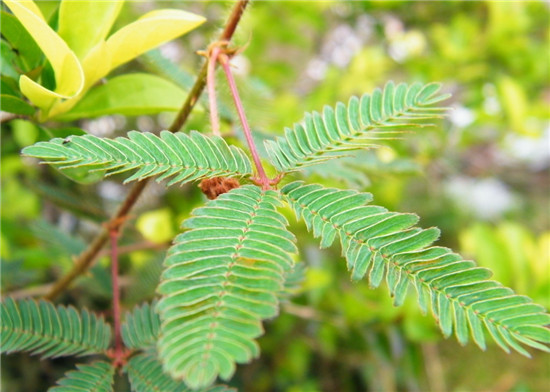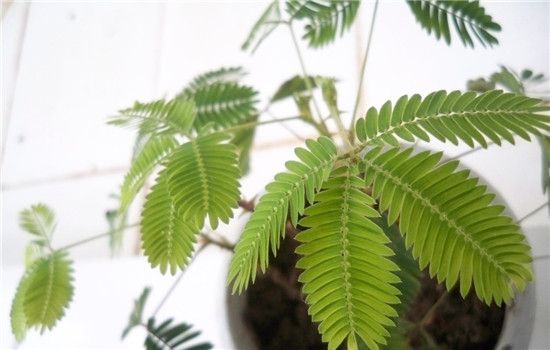The appearance and characteristics of mimosa
Mimosa has unique characteristics, giving people a sense of loveliness, which is very suitable for home decoration. Next, let's take a look at the appearance and characteristics of mimosa.

Introduction to the appearance of mimosa
Mimosa is a loose, sub-shrubby herb, its plant height can be up to 1 meter. The stem is cylindrical, with branches, with scattered, recurved hooks and anatropous spines. The stipules of mimosa are lanceolate, 5-10 mm long, with steel trade and bristles. When an external force touches the pinna and lobule, it closes and droops. The pinnae are usually 2 pairs, fingerlike arranged at the top of the total petiole, 3-8 cm long. The leaflets of mimosa have 10-20 pairs, linear-oblong, 8-13 mm long and 1.5-2.5 mm wide, apex acute, margin setose.
The head of mimosa is spherical, directly about one centimeter, with a long total pedicel, solitary or 2-3 in the axillary species of mimosa, the flower of mimosa is relatively small, the color is light red, most. Bracts linear, calyx very small, Corolla campanulate, lobes 4, outside pubescent, stamens inside flowers 4, protruding beyond Corolla, ovary shortly stipitate, glabrous; ovules 3-4, style filiform, stigma small. When the mimosa bears pods after flowering, the pods are oblong, about 1-2 cm long, flat and slightly curved. Its flowering period is from March to October and its fruiting period is from May to November.

The characteristics of mimosa
Mimosa is different from other plants because when touched by the outside world, the petiole is drooping and the small leaves are closed, which is why it is called mimosa. The mimosa is supported by the tiny reticular protein actin. When it is closed, the phosphate of the actin will fall off. If the mimosa absorbs the compound that does not let the phosphate fall off, it will not change when touched. Actin is generally found only in animals, while in plants, mimosa contains this substance. When the leaves of mimosa are touched, they will close immediately. The more powerful they are, the faster they close, the whole leaves will hang down, as if they are weak, and the whole action will be completed in a few seconds. Because the leaves and petioles of mimosa have a special structure. This structure is very sensitive to stimuli.
The role of mimosa:
The function of mimosa: 1. Ornamental
Mimosa plant shape scattered, feather leaves slender and beautiful, its leaves are closed at a touch; mimosa flowers are many and beautiful, charming, giving people the impression of weak and elegant. It can be planted in the corner of the courtyard or potted in the window. When giving flowers, gently cover the potted plants with pink tulle and tie them with pink ribbons and knots. It would be more interesting if you could adorn it with pink mohair balls.

The function of mimosa: 2. Forecast the weather
Mimosa is a wonderful plant that can predict changes in the weather. If you touch it with your hand, its leaves close quickly and open slowly, indicating that the weather will clear up; if you touch mimosa, its leaves contract slowly, droop slowly, or even reopen a little bit, this means that the weather will change from sunny to overcast or it is going to rain.
The function of mimosa: 3. Earthquake prediction
According to Turkish seismologist Erjiang, a few hours before a strong earthquake, the leaves of mimosa, which are sensitive to the outside world, suddenly shrink and then wither. In earthquake-prone Japan, scientists have found that under normal circumstances, mimosa leaves open during the day and close at night. If the leaves of mimosa close during the day and open at night, it is a sign of an earthquake.

The function of mimosa: 4. Medicinal use
It has the effects of clearing heat and diuresis, resolving phlegm and relieving cough, calming nerves and relieving pain, detoxification, removing blood stasis, hemostasis, convergence and so on. For colds, children with high fever, acute conjunctivitis, bronchitis, gastritis, enteritis, urinary calculi, malaria, neurasthenia; external treatment of swelling and pain, sores, hemoptysis, herpes zoster.
The above is all the contents of the appearance and characteristics of mimosa that I have summarized for you. I hope this article can help you. Please continue to follow us.
Related
- Wuhan Hospital Iron Tree Blooming Result Was Instantly Frightened by the Gardener Master
- Which variety of camellia is the most fragrant and best? Which one do you like best?
- What is the small blue coat, the breeding methods and matters needing attention of the succulent plant
- Dormancy time and maintenance management of succulent plants during dormancy
- Minas succulent how to raise, Minas succulent plant pictures
- What are the varieties of winter succulent plants
- How to raise succulent plants in twelve rolls? let's take a look at some experience of breeding twelve rolls.
- Attention should be paid to water control for succulent plants during dormant period (winter and summer)
- Watering experience of twelve rolls of succulent plants
- Techniques for fertilizing succulent plants. An article will let you know how to fertilize succulent plants.



